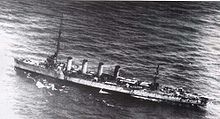- Otranto Barrage
-
The Otranto Barrage was an Allied naval blockade of the Otranto Straits between Brindisi in Italy and Corfu on the Albanian side of the Adriatic Sea in World War I. The blockade was intended to prevent the Austro-Hungarian Navy from escaping into the Mediterranean and threatening Allied operations there. The blockade, or rather the fleet capital ships in support of it, was effective in preventing surface ships from escaping the Adriatic, but it had little or no effect on the submarines based at Cattaro.
Contents
Blockade attempt
The Adriatic is 100 km (54 nmi; 62 mi) wide at the Otranto Straits. The blockade consisted mainly of a fleet of drifters, most of them British, and usually armed with a 6-pounder gun and depth charges.[1] In 1915 when the blockade was begun, perhaps 20 would be on patrol at a time, equipped with steel indicator nets intended to trap submarines or at least alert the surface vessels to their presence. The drifters were supported by destroyers and aircraft. However, the demands of the Gallipoli Campaign and other naval operations left the Otranto Barrage with insufficient resources to deter the U-boats, and only the Austro-Hungarian U-6 [2] was caught by the indicator nets during the course of the war. It was later considered that the straits had simply been too wide to be netted, mined or patrolled effectively.[1]
The ease with which German and Austrian submarines continued out of the Austro-Hungarian ports in spite of the barrage (and the success they had in disrupting shipping in the whole of the Mediterranean) strongly embarrassed the Allies, the system being called "a large sieve through which U-boats could pass with impunity".[1] In 1917–1918, reinforcements from the Australian and American navies brought the blockading force up to 35 destroyers, 52 drifters and more than 100 other vessels.[citation needed] But submarines continued to slip through until the end of the war, while only the introduction of the convoy system and better coordination amongst the Allies helped to cut the losses they were causing.[1]
Raids and battles
The Austrians mounted a number of nighttime raids against the barrage, five in 1915, nine in 1916 and ten in 1917. The largest raid was on the night of 14/15 May 1917 when the cruisers Novara, Helgoland, and Miklós Horthy, sank 14 drifters out of 47 on duty, and damaged a further three seriously.[1]
Skipper Joseph Watt was later awarded the Victoria Cross for defending his drifter Gowanlea under heavy attack from the SMS Novara. The British cruisers HMS Dartmouth and Bristol—together with Italian and French destroyers, under command of Italian Rear Admiral Alfredo Acton—steamed from Brindisi to engage the Austrians, resulting in the Battle of the Otranto Straits. The British damaged Saida and disabled Novara, severely injuring Horthy. However, the British cruisers broke off the engagement when the Italian flag officer had notice of heavy Austrian forces coming out of Cattaro and Saida towed Novara back to port. Dartmouth was damaged by UC-25 as it returned to Brindisi. The night before, the same U-boat had laid a minefield at the mouth of Brindisi harbour; the French destroyer Boutefeu struck one of these mines exiting the harbour the very same day and exploded, sinking with all hands.
In June 1918, Horthy—by now commander-in-chief of the Austro-Hungarian Navy—determined to launch an attack on the barrage employing the four Tegetthoff-class battleships based at Pola, the most modern in the fleet. While en route down the Adriatic, the dreadnought SMS Szent István was torpedoed and sunk by an Italian torpedo boat at dawn on 10 June, resulting in the attack being cancelled.
Notes
- ^ a b c d e First World War – Willmott, H.P., Dorling Kindersley, 2003, Page 186–187
- ^ Otranto Barrage article from firstworldwar.com
References
- Millholland, Ray, "The Splinter Fleet of Otranto Barrage" The Readers League of America, New York, NY, 1936
Further reading
- Halpern, Paul, The Battle of the Otranto Straits: Controlling the Gateway to the Adriatic in World War I. Bloomington, IN: Indiana University Press, 2004. ISBN 0253343798. A comprehensive account of the battle.
External links
Categories:- Austria-Hungary in World War I
- Mediterranean naval operations of World War I
- Naval battles of World War I involving the United Kingdom
- Naval battles of World War I involving France
- Naval battles of World War I involving Italy
- Naval battles of World War I involving Austria-Hungary
- Naval battles of World War I involving the United States
- History of the Adriatic Sea
Wikimedia Foundation. 2010.


